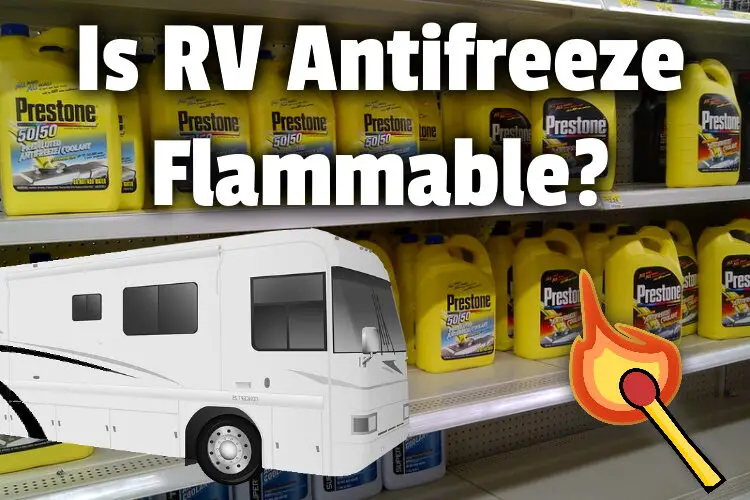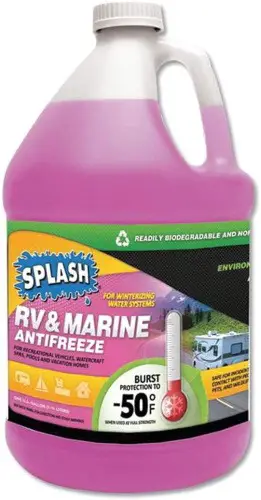As a new RV owner, you have tons of questions. If you’re reading this article, you probably know by now that your RV can be winterized with antifreeze. But this may also have you wondering, is RV antifreeze flammable?
RV antifreeze is made from propylene glycol which is flammable if it reaches 210 degrees Fahrenheit and when burning, the gasses emitted can be poisonous.
Propylene glycol is a viscous, colorless liquid. But unlike automotive antifreeze, it is non-toxic and environmentally friendly. And as weird as it sounds, it can also be found in beverages too.
But that’s not all there is to know about RV antifreeze. So just keep reading!

Is propylene glycol flammable?
Propylene glycol is combustible and has a flashpoint of 210 degrees Fahrenheit. This means that the lowest temperature at which propylene glycol will ignite is 210 degrees.
Propylene glycol has many uses.
It is primarily used in polymers, but it is also used for food applications, cosmetics, and pharmacology. It is a compound that is generally recognized as safe by the FDA. It is approved as an indirect food additive and for trapping and preserving insects.
Forty-five percent of propylene glycol produced is used in the production of polyester resins. It is also used in various food items, alcohol-based hand sanitizers, and even artificial tears.
As you know, it’s also used in antifreeze.
Antifreeze depresses the freezing point of water, and when water-propylene glycol mixtures are dyed pink, it indicates that the mixture is relatively nontoxic and environmentally friendly.
It’s used as an automotive antifreeze, aircraft de-icer, and RV and marine antifreeze. Although antifreeze for cars is more commonly made from ethylene glycol (which is much more toxic).
Fires involving propylene glycol should be put out with either a dry chemical, water spray, or alcohol-resistant foam extinguishers. You should evacuate any enclosed area where propylene glycol is burning, as poisonous gases are produced in a fire.
(source)
Finally getting the sprayer winterized today . I’m using a -30 window washing fluid … a 1/3 the price of RV antifreeze, I hope it works pic.twitter.com/TzWbAXh4ox
— Josh Schick (@JoshSchick3) December 8, 2016
Is there a difference between RV antifreeze and regular antifreeze?
RV antifreeze is made from propylene glycol and is non-toxic, whereas regular antifreeze is made from ethylene glycol and is highly toxic.
Automotive antifreeze is very toxic and harmful to the environment, people, and animals. It is meant to be put in your radiator to keep your car from overheating.
It is ethylene glycol-based, and like RV antifreeze, does not have any scent or smell on its own. It usually comes in green, orange, or yellow color, depending on what it’s mixed with.
RV antifreeze is meant to be put directly into the plumbing system to keep your plumbing from freezing.
It is propylene glycol-based and is typically dyed pink to indicate that it is non-toxic. It is safe when consumed in small amounts. It is environmentally friendly and can be used in plumbing, water tanks, and storage tanks.
Living in an RV year-round can be done, especially if you live in a more recently built motorhome. The primary factors are the temperatures where you’ll be, the amount of snow and ice in the area, and how well insulated your RV is.
But that’s not all there is to know about living in an RV during the winter months.
Just check out this recent article to learn more. In this article, I get into all the details of living in a Class A motorhome during winter, including the 1 tip that can keep pipes from freezing and bursting.
Just click the link to read it on my site.
Good ‘ol Walmart didn’t let us down when we needed to buy RV antifreeze. There was just enough left for us. I wanted to buy some last week, but we decided to wait. Now that a big #winter storm is coming later this week we can’t hold off winterizing our camper any longer 😟❄🧥🌨 pic.twitter.com/yXhUvWBkgh
— Unnamed Adventures (@UnnamedAdventu1) October 8, 2019
What is the flashpoint of propylene glycol?
Propylene glycol is combustible and has a flashpoint of 210 degrees Fahrenheit. This means that the lowest temperature at which propylene glycol will ignite is 210 degrees.
Storing propylene glycol doesn’t have any special requirements. It can be stored at room temperature for at least 2 years. It should be kept out of direct sunlight in a well-ventilated area and closed containers.
If it is overheated for long periods of time, it could become degraded more quickly, but it won’t just spontaneously combust. It is also easy to handle, as it has low vapor pressure and is not highly toxic. (source)
Even though it is easy to store and has a relatively high flash point, propylene glycol is combustible. Containers of propylene glycol may explode in a fire. (source)
If you aren’t going to use your camper or have it powered during the winter, you should winterize your camper with RV antifreeze. This is especially true if the temperature drops below 35 degrees during the day and 30 degrees at night.
To read more about winterizing your RV and how cold your pipes can get before they freeze, check out this recent article. I get into exactly what to do at different temperatures to make sure you don’t freeze and your RV avoids damage.
Just click the link to read it on my site.
The sweet smell of Rv antifreeze means #spray14 is officially over. Good feeling to start another season pic.twitter.com/lXQBSM9pTS
— Richard Book (@rabook01) August 18, 2014
Is RV antifreeze hazardous?
RV antifreeze is non-toxic. The primary component is propylene glycol. But it is meant for use in the plumbing system and should not be dumped directly on the ground.
If you accidentally spill a small amount of RV antifreeze on the ground, it will be fine. But dumping large amounts of antifreeze on the ground can be poisonous to humans, plants, and animals.
Always read the label. If it is safe to use in your freshwater system, it will be non-toxic, non-hazardous, and safe to ingest.
Generally, propylene glycol-based antifreeze is not toxic and is safe to ingest in small amounts. This means you can run it through your freshwater system. You can even pour it directly into your tank and pump it throughout your system.
Even though it can be ingested in small amounts, it can pose a risk to pets.
Typically, toxicity due to RV antifreeze is not fatal to dogs and can be flushed out with IV fluids by your vet. Of course, the more your dog ingests, the more toxic it will be. Larger dogs can ingest more than smaller dogs.
If your cat ingests any amount of propylene glycol, it could be fatal and cause kidney failure. It’s safe to assume that other pets, especially those smaller than cats and dogs, are also susceptible to being poisoned by RV antifreeze.
Im i doing this wrong? Im saving my rv antifreeze! They sell it every year like snow shovels and snow blowers #Spray2020 pic.twitter.com/fUv33ciCTo
— Lucas Criswell (@panotiller) March 9, 2020
What is the best RV antifreeze?
SPLASH RV/Marine Antifreeze is the best antifreeze, and provides protection to -50 degrees Fahrenheit and won’t damage your water pump or seals.
That’s why I recommend and use SPLASH RV/Marine Antifreeze from Amazon in my RV.
This antifreeze provides protection to -50 degrees Fahrenheit. This is the most praised feature by reviewers. It is manufactured in the U.S., which is great because it guarantees extensive testing and quality assurance. Many foreign companies don’t have the same level of testing and can cut corners to produce a cheaper product.
It’s biodegradable and non-toxic. It won’t damage your RV potable water pump or seals. It is safe to use in your potable water system.
It also doesn’t have to be diluted before use. This makes the process more straightforward and the product convenient to use.
SPLASH also gets great reviews when it comes to customer service. This is notable because it’s not often that people review customer service when reviewing products. If customers are reviewing customer service, it means that it truly is exceptional.
CLICK HERE to see Splash antifreeze on Amazon.
If you are storing your RV, you can use pressurized air to blow the water out of your system. Then use a bit of this in your sink and tub drain traps to prevent the pipes from freezing.
It’s great for winterizing your RV, but it can also be used to winterize your swimming pool and your boat.
Living in your 5th wheel during the winter can be done with a few precautions. You’ll need to make sure your doors, windows, and rooftop vents are properly insulated.
You should get heating wires for your pipes and have extra propane or butane gas on hand for cooking.
To read more about how to winterize your 5th wheel for winter living, check out this recent article. 5th wheels can be a little different from motorhomes, but it’s crucial to make sure to follows all the steps to make sure it’s ready for the cold.
Just click the link to read it on my site.
Final Thoughts
RV antifreeze is combustible and may explode if closed containers are set on fire. But in and of itself, it’s relatively safe. And it can’t ignite below 210 degrees Fahrenheit.
RV antifreeze should be stored in a cool, well-ventilated area, out of direct sunlight.
Unlike automotive antifreeze, it is non-toxic and not hazardous to the environment. But you should still use care when using it or disposing of it.
Photo which requires attribution:
Wal-Mart Malaise by artistmac is licensed under CC2.0 and was cropped, edited, and had a text and graphic overlay added
Middle Class Dad is a participant in the Amazon Services LLC Associates Program, an affiliate advertising program designed to provide a means for sites to earn advertising fees by advertising and linking to Amazon.com. As an Amazon Associate, I may earn a small commission from qualifying purchases if you click to Amazon from my site and choose to make a purchase. This is no way increases the cost to you.

